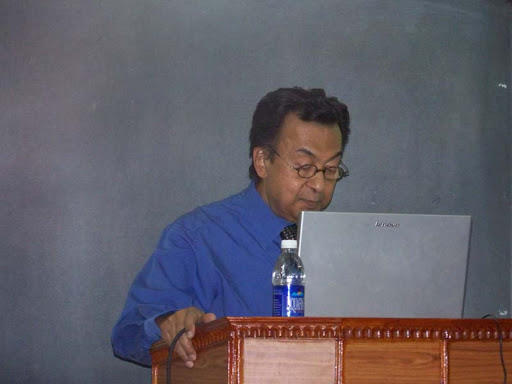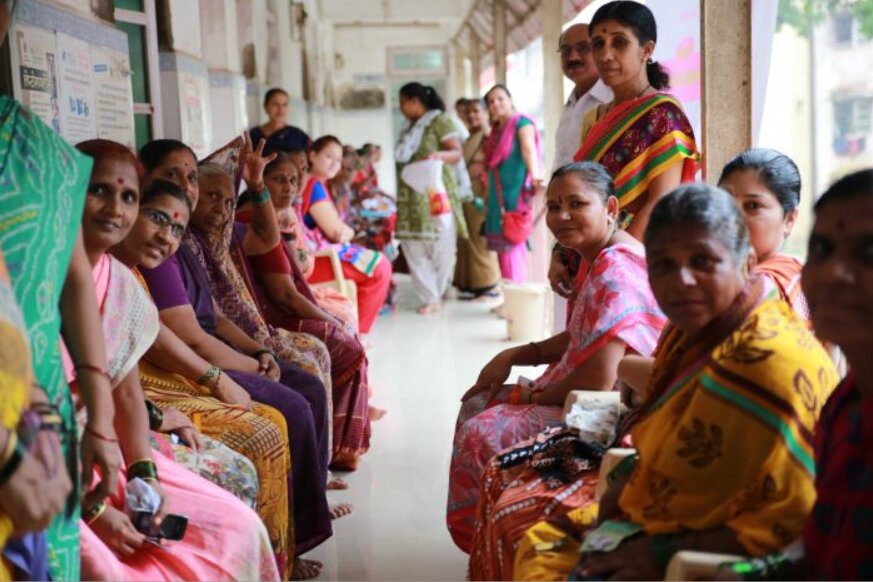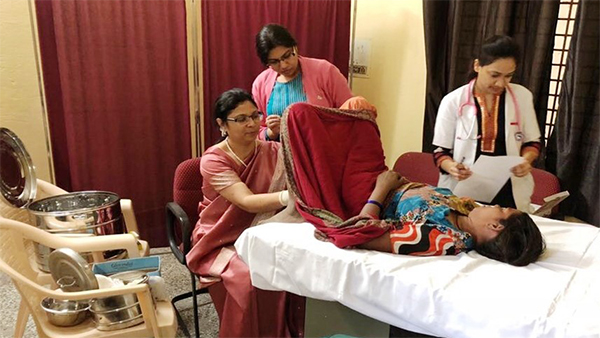When Lady Meherbai Tata died of leukaemia on 18 June 1931, her husband, Sir Dorabji Tata, Jamsetji Tata’s son and a key figure of the Tata Group endowed the Lady Tata Memorial Trust with a corpus for research into leukaemia in memory of his wife. He set out to establish high-quality facilities for cancer treatment in India.
(Images above of Dr. Indraneel Mittra and a representational photo of middle-aged women.)
Out of this humanitarian commitment emerged the now well-renowned Tata Memorial Hospital, commissioned by the Sir Dorabji Tata Trust on 28 February 1941.
Today, the Tata Memorial Centre, under whose aegis the Tata Memorial Hospital operates, is comparable to any such centre in the world. Over the years, the centre has achieved much in cancer treatment and research, besides producing some of India’s finest surgeons, thanks to the far-sighted and complete support of the Department of Atomic Energy, which has taken responsibility for managing this institution since 1962.
One such surgeon is Dr Indraneel Mittra, whose groundbreaking 20-year research into the early detection of breast and cervical cancer in the 1990s saved thousands of lives.
Joining the Tata Memorial Hospital in 1982 as a Consultant Surgeon in the Department of Surgical Oncology, he would go on to set up the first dedicated Breast Unit in India and became the Chief of Breast Cancer Service at the Tata Memorial Hospital (TMH).
In the same year, the Indian Council of Medical Research’s network of cancer registries under the National Cancer Registry Programme (NCRP) began collecting data and providing information on incidence and cancer patterns across the country.

Embarking on Groundbreaking Research
Responding to The Better India’s queries over email, Dr Gauravi Mishra, a professor at the Department of Preventive Oncology, TMH, talks about what motivated Dr Mittra.
“Being a breast surgeon, he was troubled with women constantly presenting with advanced-stage breast cancer, and he initiated his work to investigate if it was possible to detect them at an earlier stage. However, community-based early detection trials needed funds that were scarce then. According to the Bombay Cancer Registry data back then, 50 per cent of breast cancers were detected in stages III and IV at the time of diagnosis when chances of cure were remote. As many as 21 per cent of women who developed breast cancer in Mumbai died within the first year of diagnosis, suggesting that they already had the metastatic form of the disease,” says Dr Mishra.
But even before Dr Mittra could embark on his research, there were some structural barriers he had to overcome. For example, in this Twitter thread, Dr CS Pramesh, the Director of TMH, talks about when cancer surgery was celebrated – and research ridiculed.
“Surgeons, and especially cancer surgeons, were renowned for their technical prowess and their sheer bravado – ‘wherever cancer, however advanced, I will take it out’. So, our surgeon-researcher [Dr. Mittra] was ridiculed for even attempting clinical research…For a surgeon, he couldn’t have chosen a worse topic to research on: early detection. [This had] nothing to do with surgery or even treatment. Remember, this was the 1990s, [a time when] cowboy surgery was celebrated, and research ridiculed,” he writes.
With funding hard to come by, Dr Mittra called up a friend in the early 1990s, “who was a corporate leader with an Indian consumer company, and asked him to fund a pilot.”
“The study was [also] funded in part by a research grant from the World Health Organization (WHO). In addition to breast and cervical cancer, direct inspection of the oral cavity to detect oral cancer was included in the pilot study. The women were drawn from socio-economically disadvantaged populations in Mumbai,” notes Dr Mishra.
Amongst the several modalities to screen cervical and breast cancers (the two most common cancers among women in India) – Visual Inspection Acetic Acid (VIA), and Clinical Breast Examination (CBE) are low cost and feasible for population-level screening in India.
As per a paper in the Journal of the National Cancer Institute published in 2014, “Visual inspection with acetic acid (VIA) is a simple, inexpensive test with moderate sensitivity and specificity for screening that can be combined with simple treatment procedures for early cervical lesions. Health workers or nurses can be trained as test providers; the results are available immediately.” CBE refers to a simple physical examination of the breast done by a health professional.
According to Dr Mishra, initially, a pilot study was conducted wherein 2,000 women were examined. This was done to:
-Evaluate the response of women in the community to an early detection programme
-The womens’ interest in awareness camps
-The help and cooperation that could be expected from community leaders
-The level of cancer awareness in the community
-The number of examinations female health workers (FHWs) could perform per week, etc.
The women were examined independently by FHWs. Subsequently, female gynaecologists examined the same women and evaluated the quality of examinations being conducted by FHWs.
Following a successful pilot study, which also evaluated women’s response for early detection of cervical cancer, Dr Mittra applied for a Research Project Grant (R01) for breast and cervical cancer from the National Institutes of Health (NIH), a US-government agency responsible for public health research. Cervical cancer was then the most common cancer among Indian women and hence included in the study.
“Cancer of the cervix was then the commonest cancer in India and given a country-wide crude incidence rate of 18 per 100,000; nearly 124,000 women develop cancer of the cervix in India each year. The early age of consummation of marriage, poor genital hygiene and infection with human papillomavirus are responsible for this high incidence. Nearly 70 per cent of patients with cervical cancer in India present at Stage III and IV, and it is estimated that 77,000 women die of cervix cancer each year. Further, most of the women dwelling in the low socio-economic areas had no access to any form of healthcare,” notes Dr Mishra.
After receiving the NIH grant, Dr Mittra’s team of investigators commenced their community-based cluster-randomized trial evaluating the role of Visual Inspection Acetic Acid and Clinical Breast Examination for early detection of cervical and breast cancer, respectively, on 22 May 1998. A total of 104 people worked on this 20-year study.

Aims of the Study
“The primary aim of the study was to evaluate in a community based randomized trial whether simple and low-cost technology approaches such as physical examination of the breast (and teaching of BSE) and direct inspection of the cervix would be effective in down-staging these cancers at diagnosis and eventually lead to a reduction in mortality from breast and cervix cancers,” says Dr Mishra.
The examination of over 1,50,000 enrolled women (75,360 in the screening arm and 76,178 in the control arm) between the ages 35 and 64 years in the slums of Mumbai over the course of the next 20 years would be performed by trained female health workers (FHWs).
Meanwhile, according to Dr Mishra, the secondary aims of the study include:
1. To estimate cost and resource needs of a programme of early detection using simple techniques
2. To determine behavioural, cultural and psychological factors that influence participation in a trial of early detection
3. To determine if simple techniques can become an integral part of the public health care approach to controlling common cancers in women in a developing country.

Challenges of this Study
As Dr Pramesh notes in his Twitter thread, the challenges were enormous, including the “screening of [over] 75,000 women with VIA and CBE every two years for eight years, and following up [over] 150,000 women for 20 years, recording every cancer, [and] recording every death”. Making matters harder, they had to follow up with these women, residents of Mumbai slums, where “migration was the rule rather than the exception.” However, without the able support of his mentee, Dr Ranjan Bade, the current director of the TMC, “idealistic” preventive oncology physicians like Dr Mishra and over 100 “dedicated” high school educated FHWs, this study would not have been possible.
Speaking to The Better India, Dr Mishra elaborates on some of the more immediate challenges.
“One of the initial challenges was to map the selected slums and create a list of eligible women for the study. The second was completing one round of intervention by contacting 151,538 participants with the stipulated time of 24 months. Establishing a referral system of screen positives (women at greater risk) to TMH was important. But once women were identified as screen positives either for CBE or VIA, a mammoth task was convincing them to visit TMH for further diagnostic investigations and ensuring that they do,” she notes.
However, according to Dr Mishra, the biggest challenge was reaching participants who had relocated from their dwellings during the subsequent follow-up rounds, considering the ongoing large and frequent slum rehabilitation projects. She adds that their medical social workers adopted many innovative strategies to trace the participants.
“The screen positives were accompanied by health assistants to TMH. In case they did not choose to come to TMH and preferred to avail treatment from other hospitals of Mumbai, the TMH team would visit other hospitals to collect treatment details of the participants. If treatment details from other hospitals were not available with the participants, a duly signed consent form was collected from them. The details of treatment were meticulously searched from the different hospital medical records, and the database was updated,” she explains.
This process of gathering information from other Mumbai hospitals was carried out systematically with a prior written request letter signed by the concerned authority from the Department of Preventive Oncology of Tata Memorial Hospital.
“In the event, a participant died, the death certificate and cause of death certificate were collected from their relatives. Due to slum rehabilitation, most of our women shifted to different parts of Mumbai. A few of them relocated outside Mumbai. It was a herculean task to trace them and update the database with their new contact details. Trained Medical Social Workers did the primary collection of data through home visits. We could capture 85 to 90 per cent of data in this manner. To ensure our data was complete, we also matched it with Mumbai Municipal Death Records and the Mumbai Cancer Registry,” notes Dr Mishra.

Results of the Study
“The results of the study showed a 30 per cent reduction in mortality due to breast cancer in women aged 50 years and above. This degree of mortality reduction is similar to that from mammography. Although this study did not find benefit in women below the age of 50, it did find a 34 per cent reduction of mortality in these women provided they regularly attended all four rounds of screening. These results started coming in after 20 years. Meanwhile, the results also showed a 31 per cent reduction in cervical cancer mortality in the screening group than the control group across all age groups. Results for cervical cancer started coming after 12 years of follow-up. These results were finally published in 2014,” says Dr Mishra.
In his Twitter thread, Dr Pramesh notes “a 31% reduction in cervical cancer mortality, using a low-cost and low-tech method, which [was] soon adopted by several Indian states.”
How many lives can be saved by VIA and CBE in India?
“VIA screening conducted by PHWs significantly reduced cervical cancer mortality. VIA screening is easily implementable and could prevent 22,000 cervical cancer deaths in India and 72,600 deaths in resource-poor countries annually. Meanwhile, if implemented as a breast screening method in India, CBE would save 15,000 deaths from breast cancer each year and 40,000 lives globally in LMICs (low and middle-income countries). All this is at a fraction of screening cost, thereby reducing stress on the overburdened healthcare systems,” says Dr Mishra.
Legacy
On a more immediate level, the Mumbai study is clearly a stimulus for more research to help mitigate the problems of over-detection and overtreatment. “Some studies further indicate that about 15-35% of women are non-compliant to mammography due to certain factors like physical discomfort, fear of procedure and delay in receiving results. CBE could easily serve as a more acceptable, humane and quick screening intervention,” adds Dr Mishra.
However, the enduring legacy of Dr Mittra is the fact that his research work has, directly and indirectly, saved the lives of thousands of women with breast and cervical cancer.
(Edited by Vinayak Hegde)
Resource Material:
-Hospital Cancer Registry. Annual Report, 1993; Tata Memorial Hospital, Bombay, 1995.
-Mittra I, Badwe RA, Desai PB, Yeole BB, Jussaawalla DJ : Early detection of breast cancer in developing countries. Lancet i : 719-720, 1989.
-National Cancer Registry Programme. Biennial Report. Population Based Cancer Registry, 1988-89. An Epidemiological Study. Technical Wing (Delhi). NCRP, Indian Council of Medical Research, New Delhi, 1992.
–Press Note – Released by Tata Memorial Hospital, Mumbai (25.02.21)
–Tata Central Archives
–Tata Trusts
–Visual Inspection with Acetic Acid (VIA) Screening Program: 7 Years Experience in Early Detection of Cervical Cancer and Pre-Cancers in Rural South India-Link
No comments:
Post a Comment